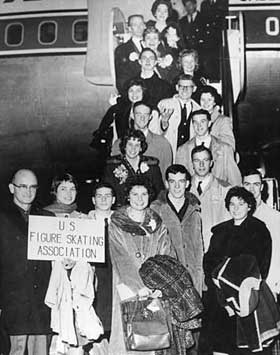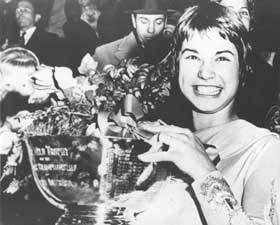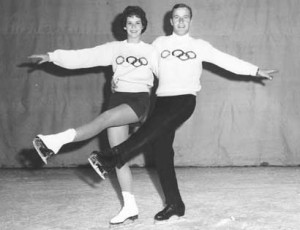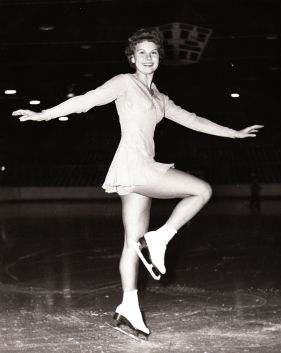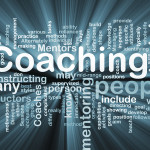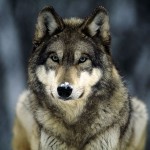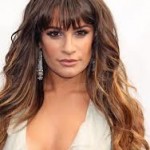RISE
Este jueves 17 de febrero se ha estrenado en Estados Unidos un film documental sobre el 50 aniversario de la tragedia que conmovió el mundo del patinaje artístico en 1961, cuando el equipo mundial de patinaje artístico de Estados Unidos murió en accidente de aviación, en el vuelo Sabena Airlines Flight 548, cuando se dirigían al campeonato Mundial que se celebraba en Praga, Checoslovaquia.
Los ganadores de 16 Emmys Lookalike Productions producen y dirigen RISE, que documenta el crecimiento en popularidad de este deporte a través de los años y el perfil de varios de los mejores patinadores americanos.
RISE es una historia inspiradora acerca del poder del espíritu humano a través de un grupo de individuos que se convirtieron en iconos de la historia Olímpica del deporte y que sembraron esperanza y sueños de éxito en la gente.
Como narradores de la historia, RISE presenta a las leyendas del patinaje artístico Peggy Fleming, Dorothy Hamill, Scott Hamilton, Brian Boitano y Michelle Kwan, quienes nos conducen a través de grandes momentos a la vida de esos nombres inmortales del equipo mundial de 1961. Un sentido y espectacular homenaje a los 34 patinadores, oficiales, jueces, entrenadores y sus familias que perdieron sus vidas en el fatídico accidente, que tuvo lugar cerca de Bruselas, Bélgica.
RISE se ha estrenado en 500 cines, incluyendo AMC Entertainment Inc., Celebration! Cinema, Cinemark USA Inc., Clearview Cinemas, Cobb Theatres, Georgia Theatre Co., Goodrich Quality Theatres, Hollywood Theaters, Rave Motion Pictures, R/C Theatres and Regal Entertainment Group movie theaters, The Beacon Cinema (Pittsfield, MA), Carolina Theatre (Asheville, NC), Palace Cinema 9 (South Burlington, VT) y Penn Cinema (Lititz, PA), a través de NCMs exclusivo Digital Broadcast Network
RISE
With: Brian Boitano, Frank Carroll, Peggy Fleming, Dorothy Hamill, Scott Hamilton, Michelle Kwan
Director-producers: Lisa Lax, Nancy Stern Winters
Screenwriter: Maggie Monteith
Director of photography: Scott Duncan
Production designer: Cassandra Boyd
Music: Peter Calandra
Editor: Ray Conley
76 minutes
Coordinating Producer: Rebecca Gitlitz
Associate Producer: Amanda Postel
Line Producer: Deni Graap
Field Producer: Jim Fabio
Sound Mixer: Dave Smith
Production Designer: Cassandra Boyd
Creative Consultants: the watsons
Production Assistant: Adrienne Henry
Research Consultant: Patty Bushman
Los miembros del U.S. Figure Skating Championships de 1961:
Roger Campbell
1961 U.S. ice dancing silver medalist
Roger Campbell, 18, competed with a succession of ice dancing partners but still managed to medal every year at the U.S. Figure Skating Championships. The only child of Alexander and Ann Campbell, he began figure skating at age 13 when his family moved from Portland, Ore., to southern California. He joined the Los Angeles Figure Skating Club, and his coaches included Mabel Fairbanks, Bert Wright and Bill Kipp. He won the junior silver medal with Diane Sherbloom at the 1959 U.S. Championships in Rochester, N.Y. When the partnership dissolved, he and his new partner, Yvonne Littlefield, joined the Arctic Blades Figure Skating Club. They placed third at the 1960 U.S. Championships in Seattle and eighth at the 1960 World Figure Skating Championships in Vancouver. Campbell and Littlefield continued to train together, but in September 1960, Campbell suddenly switched partners and began training with Dona Lee Carrier. In the 1960–61 season they swept the senior titles on the west coast, winning both the Southwest Pacific Regional and Pacific Coast Sectional championships. They placed second at the 1961 U.S. Championships at the Broadmoor in Colorado Springs and two weeks later won the silver medal at the North American Figure Skating Championships in Philadelphia. Roger’s mother, Ann, who was very supportive of her son, was the only non-coaching parent who flew with her child to Prague.
Dona Lee Carrier
1961 U.S. ice dancing silver medalist
Dona Lee Carrier, 20, had never competed at the national level until 1961. The only child of Reverend Floyd and Eleanor Carrier, she was born in National City, Calif. When she was 11 she began skating in Seattle. After a move to Troy, N.Y., she trained with Mary Lou Butler in both singles and ice dancing. The Carrier family moved to Southern California in 1958, and Dona Lee found a welcoming community in the Los Angeles Figure Skating Club (LAFSC). Coached by Bert Wright at the Polar Palace in Hollywood, she had difficulty finding a permanent ice dancing partner. In club and regional competitions she competed in pairs and ice dancing; her partners included Roger Campbell, Howie Harrold and Dr. Robert Wilkins. When U.S. World Team members Roger Campbell and Yvonne Littlefield dissolved their partnership, Lee and Campbell began skating together in September 1960, with Bill Kipp as their coach. When they claimed the 1961 Southwest Pacific Regional and 1961 Pacific Coast Sectional ice dancing titles, it marked the first time Lee had won a competition. They earned a berth on the 1961 U.S. World Team when they placed second at that year’s U.S. Figure Skating Championships. They were delighted to capture the silver at the North American Figure Skating Championships in Philadelphia.
Robert and Patricia Dineen
1961 U.S. Ice Dancing Bronze Medalists
Patricia Barbara Major Dineen, 25, and Robert Francis Dineen, 25, were born just days apart in different boroughs of New York City but eventually came together to form a partnership both on and off the ice. Bob Dineen was the son of Judge Benedict and Mary Dineen and had two brothers, Joseph and Benedict Jr. Pat Major was the daughter of Edward and Ann Major and had one brother, Edward. Major and Dineen began skating as teenagers in the New York City metropolitan-area rinks, including the Brooklyn Ice Palace, Central Park’s Wollman Rink and Iceland at Madison Square Garden. In 1956, they formed an ice dancing partnership and moved to Los Angeles for a year, training with coach Jean Westwood. Returning to New York, they married in 1958 and continued to compete in junior dance, winning the bronze medal at the 1959 U.S. Figure Skating Championships and the silver in 1960. The Dineens trained for the 1960–61 competitive season even though Pat gave birth to their son, Robert Dineen, Jr., in the summer of 1960. Working with coaches Sonya Klopfer Dunfield and Ron Ludington, they placed third in senior dance at the 1961 U.S. Championships and earned a berth on the 1961 U.S. World Figure Skating Team. When they flew to Prague, they left their 9-month-old son in the care of Bob’s brother, Ben.
Linda Hart Hadley
1961 U.S. World Team Professional
Alvah Lynn (“Linda”) Hart, 31, did not have any competitive experience herself; yet in just five years of teaching, she was an Olympic coach. The youngest of seven siblings, she was born in Winfield, Kan. When she was a teenager, her family moved to Salem, Ore., where she learned to roller and ice skate. She changed her name professionally to “Linda” when she performed in touring skating shows. After marrying Ray Hadley Sr. in 1954, she taught alongside her husband at the Seattle Civic Arena as well as the Ballard, Tacoma and Yakima rinks. Hart taught singles and pairs, and Hadley taught ice dancing. They both taught Hadley’s children—Ila Ray Hadley and Ray Hadley Jr.—who competed in all three disciplines. Hart was an innovative coach; she was a good choreographer and introduced new moves in her students’ routines. Ray Hadley Sr. and Hart opened their own rink—the Hadley and Hart Ice Studio—in November 1960. The Hadley siblings won the 1957 U.S. junior pairs title, and Hart accompanied them to Paris, where they performed exhibitions at the 1958 World Figure Skating Championships. They competed at the 1960 Olympic Winter Games and placed second at the 1961 U.S. Figure Skating Championships. Ray Hadley Sr., who stayed behind to run their studio, planned to meet his wife and children in Prague for the 1961 World Championships later in the week.
Ila Ray and Ray Hadley Jr.
1961 U.S. Pairs Silver Medalists
Ila Ray Hadley, 18, and Ray Hadley, Jr., 17, were the children of Ray and Bette Hadley. “Ray” was the maiden name of their paternal grandmother. Their parents met through roller skating in Eugene, Ore., and Ray Hadley Sr. taught his children both roller and ice skating. After the family moved to Seattle in 1951, the parents divorced, and Ray Hadley Sr. was awarded custody. Ila Ray was 11 and Ray Hadley Jr. was 10 when their father married Linda Hart in 1954. Hart was their primary coach, teaching them in both pairs and singles. They trained at the Seattle Civic Arena, the Tacoma rink, the Ballard rink, the Yakima rink and, in time, the Hadley & Hart Ice Studio in 1960. On their second trip to the U.S. Figure Skating Championships, the Hadleys won the 1957 U.S. junior pairs title in Berkeley, Calif. They went to Paris as the 1958 U.S. World Team alternates and performed exhibitions. After placing fourth in senior pairs in 1958 and 1959, they won the bronze medal at the 1960 U.S. Championships and earned a berth on the 1960 U.S. Olympic Team. In 1961, they placed second in senior pairs at the U.S. Championships and fourth at the North American Championships. The Hadleys almost didn’t travel to Philadelphia and Prague because of financial issues, but contributions from the Seattle skating community and a loan from the Seattle Skating Club allowed the family to fly to the 1961 World Figure Skating Championships.
Bill and Laurie Hickox
1961 U.S. Pairs Bronze Medalists
William (“Bill”) Holmes Hickox, 18, and Laurie Jean Hickox, 15, won the 1960 U.S. junior pairs championship but did not plan to compete in 1961. Born in San Francisco, they were the only children of Lute and Elinor Hickox of Berkeley, Calif. Elinor gave birth to Bill at age 40, and the couple adopted Laurie at birth. Bill competed in singles for several years on the national level, but Bill and Laurie excelled as a pairs team. They first represented the St. Moritz Ice Skating Club and then switched to the Skating Club of San Francisco. The siblings trained at both the Iceland rink in Berkeley and the Sutro’s rink in San Francisco. Their coaches included Maribel Vinson Owen, Robert Swenning, Gene Turner, Bill and Julie Barrett, and Edi Scholdan. After winning the 1960 U.S. junior title, Bill retired from competitive skating. A brilliant student, he entered the Air Force Academy in Colorado Springs in June 1960. Bill had been off the ice for six months when his mother convinced him to enter the 1961 U.S. Figure Skating Championships with Laurie at the nearby Broadmoor World Arena. After placing third in senior pairs at the 1961 U.S. Championships, the academy granted Bill permission to miss school and travel to a communist country. Laurie was the youngest member of the 1961 U.S. World Figure Skating Team.
Gregory Kelley
1961 U.S. men’s silver medalist
Gregory (“Greg”) Eric Kelley, 16, hoped to follow in the footsteps of Hayes Jankins and David Jenkins, and become coach Edi Scholdan’s third Olympic champion, in 1964. The youngest of Dr. Vincent and Nathalie Kelley’s six children, he grew up in Newton, Mass. Kelley began skating at age 8 when his Catholic school class attended a learn-to-skate program at the Skating Club of Boston. He joined the club and trained with Montgomery (“Bud”) Wilson. At the Eastern Sectional Figure Skating Championships, he won the men’s title at every level, and in his first trip to the U.S. Figure Skating Championships he won the 1957 novice men’s title in Berkeley, Calif. He had never lost a championship event until the 1958 U.S. junior men’s competition, where he placed second. Greg’s eldest sister, Nathalie Frances Kelley, was Greg’s chauffer and support system, traveling with him to competitions and to Michigan State University in East Lansing for summer training. After he won the 1959 U.S. junior men’s title, Kelley moved to Colorado Springs to train with Edi Scholdan at the Broadmoor. Nathalie moved with him and became his personal tutor. Kelley placed fifth at the 1960 U.S. Championships, second at the 1961 U.S. Championships and won the bronze medal at the 1961 North American Figure Skating. A brilliant student, Kelley had plans to become a doctor like his father.
Bill Kipp
1961 U.S. World Team coach
William (“Bill”) Robert Kipp, 28, did not fulfill his own competitive dreams but blossomed into one of the most promising coaches in the country. The youngest child of Martin and Wilhelmina Kipp, he grew up with three older brothers and two older sisters in Allentown, Pa. He learned to skate on the ponds near his home as a boy, joined the Penguin Figure Skating Club, and traveled to Philadelphia and Lake Placid to train with coach Bill Swallender. Bill Kipp was a gold medalist in figures, freestyle and ice dancing. His ice dancing partners included Theda Beck, Janet Williams and Virginia Hoyns. Though he never won a U.S. medal, he captured the bronze at the 1955 North American Figure Skating Championships. He had an opportunity to perform in Ice Follies but instead became a coach at the Iceland rink in Paramount, Calif. His students won the 1956 and 1960 U.S. ice dancing titles. Kipp taught in Lake Placid, N.Y., during the summers, and he and professional partner Jean Westwood were the stars of the Saturday night shows. In September 1960, he began coaching the ice dancing team of Dona Lee Carrier and Roger Campbell, who placed second at the 1961 U.S. Figure Skating Championships and second at the 1961 North American Championships. Also a pairs and singles instructor, Kipp steered Rhode Lee Michelson to a third-place finish at the 1961 U.S. Championships. (She had to pull out of the World Championships due to injuries.) Kipp, who also taught 12-year-old Peggy Fleming, had become senior professional at Iceland when he left for Prague.
Bradley Lord
1961 U.S. men’s champion
Bradley Richard Lord, 21, formed two ambitions early in life: to make the Olympic Team and to star in the touring professional show Ice Follies. Born in Swampscott, Mass., he was the son of Roy (“Lefty”) and Alfreda Lord, and had an older brother, Bruce. At age 5, Bradley began skating on a makeshift outdoor rink across the street from his home and soon fell in love with skating. He first trained with Lillian Tribby at the North Shore Sports Center in Lynn, and then switched to coach Montgomery (“Bud”) Wilson at the Skating Club of Boston. In the summers, he trained with his coach in Saint Paul, Minn., and at Michigan State University in East Lansing. Lord made his first trip to the U.S. Figure Skating Championships in 1953. In 1956, he placed third in junior men, and the following year became the 1957 U.S. junior men’s champion. That same year he entered the School of Fine and Applied Arts at Boston University to study commercial art. Lord competed in senior men’s at the U.S. Championships for four years. Placing fourth at that competition in 1960, he was heartbroken to not make the U.S. Olympic Team. He was, however, able to compete at the 1959 World Figure Skating Championships in Colorado Springs and at the 1960 World Championships in Vancouver. In 1961, Lord became the U.S. men’s champion and two weeks later won the silver medal at the 1961 North American Figure Skating Championships. His coach, Bud Wilson, did not fly with the 1961 U.S. World Team, electing to join Lord later in the week.
Rhode Lee Michelson
1961 U.S. ladies bronze medalist
Rhode Lee Michelson, 17, was considered the most powerful female free skater of her time. Born in Long Beach, Calif., she was the daughter of Arthur and Martha (“Marty”) Michelson. Rhode first began speedskating, along with her father and younger brother, Mike, at the Iceland rink in Paramount, Calif. She was also a champion baton twirler, but by age 11 she had committed herself to figure skating. Michelson trained with Jean Westwood and then with Bill Kipp in Paramount, and trained several summers with Kipp in Lake Placid, N.Y. Representing the Arctic Blades Figure Skating Club, she was the 1958 U.S. novice ladies champion. In junior ladies competition, she won the U.S. bronze medal in 1959 and the silver in 1960. A dynamic free skater, her signature moves were a traveling camel spin and clean double Axels. More than anything else, Michelson, who still competed in a few speedskating races for fun, skated with tremendous speed. At the 1961 U.S. Figure Skating Championships, she pulled up from fifth in figures to third place and earned a berth on the 1961 U.S. World Figure Skating Team. She had to withdraw from the 1961 North American Figure Skating Championships due to an injury. Rhode had often skated when injured, but when doctors warned her that she might be off the ice for several months if she didn’t listen to them, she obeyed. She was determined to go to Prague and compete at the 1961 World Figure Skating Championships.
Laurence Owen
1961 U.S. Ladies Champion
Laurence Rochon Owen, 16, had many distinguished titles—scholar, pianist, dancer, linguist and writer—but she was foremost a figure skater. Her mother, Maribel Vinson Owen, groomed her to accomplish what had eluded Maribel: winning an Olympic gold medal. Born in Berkeley, Calif., she was named after her paternal grandmother, Laurence Rochon, of Ontario, Quebec. She began skating at age 2 at the Berkeley Iceland rink where her parents, Maribel and Guy Owen, coached. She skated daily, but her competitive success was slow in coming. She competed in pairs for one year with Bill Hickox, but their partnership ended when she moved with her mother and sister, Maribel Owen Jr., to Winchester, Mass., in 1954. She joined the Skating Club of Boston and won the Eastern Sectional junior title in 1956 but had to withdraw from her first U.S. Figure Skating Championships when she broke her wrist. In 1958 she won the U.S. junior bronze medal and the following year won the 1959 U.S. junior title. Laurence won many fans with her artistry and joyful spirit on the ice. After placing third at the 1960 U.S. Championships in Seattle, she was named to the 1960 U.S. Olympic Figure Skating Team, for which she placed sixth in Squaw Valley, Calif. In 1961, she won both the U.S. title and North American titles. She was expected to win a medal at the 1961 World Figure Skating Championships in Prague. Laurence, who had received early admission to Radcliffe, had dreams of becoming a writer.
Maribel Vinson Owen
1961 U.S. World Team Professional
Maribel Vinson Owen, 49, was perhaps the most influential figure in the history of U.S. figure skating until her passing. Exhibiting a strong personality and a fearless nature, she was one of the most decorated U.S. female skaters in the 20th century and was one of its most successful coaches. Born in Winchester, Mass., she was the only child of Thomas and Gertrude Vinson, who were both skaters themselves. Taught by Willie Frick at the Skating Club of Boston, she won several U.S. ice dancing championships; the U.S. pairs championship six times, with partners Thornton Coolidge and George E. B. Hill; and the U.S. ladies championship nine times—a record that was equaled 68 years later by Michelle Kwan. She retired from competition in 1937 with one World bronze medal, one World silver medal and one Olympic bronze medal. After she married Canadian champion Guy Owen, they performed in ice shows together and taught in St. Paul, Minn., Berkeley, Calif., and Boston. Maribel’s students included six-time U.S. champion Gretchen Merrill, 1956 Olympic champion Tenley Albright and 1960 Olympic pairs bronze medalists Ron and Nancy Ludington. She also taught her two daughters, 20-year-old Maribel Owen Jr., the 1961 U.S. pairs champion with Dudley Richards; and 16-year-old Laurence Owen, the 1961 U.S. and North American champion. A Radcliffe graduate, Maribel was the author of three books on figure skating, the first female sports writer for The New York Times and an AP correspondent. By 1961, she had taught more than 4,000 students.
Maribel Y. Owen
1961 U.S. Paris Champion
Maribel Yerxa Owen, 20, named after her mother, Maribel Yerxa Vinson Owen, had several nicknames, including Little Maribel and Maribel Jr. She didn’t become a singles champion like her mother, but she was a successful pairs skater with two different partners. She was born in Boston, Mass., but grew up in Berkeley, Calif. She began skating at age 2 and trained daily alongside her parents, Maribel and Guy Owen, who taught at the St. Moritz Ice Skating Club at the Iceland rink. However, she did not immediately succeed competitively. After her parents divorced, she, her mother and her sister, Laurence, moved to her mother’s hometown of Winchester, Mass., in 1954 and joined the Skating Club of Boston. After her singles career stalled, her mother invited 20-year-old Chuck Foster to compete in pairs with her 14-year-old daughter, and together they won the 1955 U.S. junior title in their first year of competition. After winning the 1956 U.S. senior bronze medal, they retired when Chuck graduated from Harvard. A year later, Maribel Owen Jr. formed a pairs team with long-time competitor Dudley Richards. They competed at the 1960 Olympic Winter Games in Squaw Valley, Calif., and were the 1961 U.S. pairs champions and the silver medalists at the 1961 North American Figure Skating Championships. There was speculation that Maribel Owen Jr. and the 29-year-old Richards would announce their engagement after returning from the 1961 World Figure Skating Championships in Prague, Czechoslovakia.
Larry Pierce
1961 U.S. ice dancing champion
Dallas Larry Pierce, 24, was one of the most popular male ice dancers of his era. The second child of Dallas and Nellie Pierce, Larry was raised in Indianapolis with his older sister, Jan, and younger brother, Russell. Larry was a recreational skater at the Indiana State Fairgrounds Coliseum and didn’t start competing until he graduated from high school—the same time that coach Danny Ryan moved to the Winter Club of Indianapolis. Ryan put Pierce and Marilyn Meeker together as a dance team. Together, they won the 1957 Midwestern Sectional bronze medal, placed third in junior at the 1958 U.S. Figure Skating Championships and captured the 1959 U.S. junior title. During the summers, Pierce and Meeker trained with Ryan in Cobourg, Ontario, and Lake Placid, N.Y. Pierce generously partnered with other dancers for their tests at Lake Placid and in many other Midwestern cities. He prepared for the 1959-60 season while simultaneously serving in the Marines. Pierce and Meeker placed second at the 1960 U.S. Championships in Seattle and fifth at the 1960 World Figure Skating Championships in Vancouver. Seven weeks before the 1961 U.S. Championships, Meeker had an accident in practice and broke her ankle, eliminating her from competition. Ryan invited Diane Sherbloom of Los Angeles to compete with Pierce. After five weeks of training, they won the 1961 U.S. title at the Broadmoor in Colorado Springs and placed fourth at the 1961 North American Figure Skating Championships in Philadelphia.
Doug Ramsay
1961 U.S. World Team alternate
Douglas Alexander Ramsay, 16, was both a hockey enthusiast and an extraordinary free skater who has been compared to champions Dick Button, Ronnie Robertson, David Jenkins and Scott Hamilton. Ramsay was the second child of Alex and Jean Ramsay’s four children. His little brother, David, never skated but sisters Judy and Christine skated briefly with him at the Detroit Skating Club. At age 8, Doug began training with coach Bill Swallender and traveled with him to Canada, Lake Placid, N.Y., and East Lansing, Mich., for summer skating. Beginning in 1955 he enjoyed a string of Midwestern championships, winning the juvenile, novice and junior titles. Due to weak figures, he had limited success at the U.S. Figure Skating Championships, but in 1960 he captured the junior men’s title in one of the closest results in history. At the 1961 U.S. Championships, Ramsay placed fourth and was named first alternate to the 1961 U.S. World Figure Skating Team. When bronze medalist Tim Brown withdrew due to health problems, U.S. Figure Skating invited Ramsay to join the team a week before the 1961 North American Figure Skating Championships. Although Ramsay placed fourth in Philadelphia, he was a huge sensation at his first international competition. The last-minute inclusion of Ramsay on the 1961 U.S. World Team prompted his coach, Bill Swallender, to fly with him to Prague.
Dudley Richards
1961 U.S. Pairs Champion
Dudley Shaw Richards, 29, had the longest competitive record of any skater of his era. The second child of Byron and Ruth Richards, he grew up in Pawtucket, R.I., with his brother, Ross, and his sister, Susan. Dudley began skating with the Providence Figure Skating Club at age 9. He then trained with Montgomery “Bud” Wilson at the Skating Club of Boston and won the title at every Eastern Sectional Figure Skating Championships he entered. After he won the 1946 U.S. novice title, he broke his neck in a diving accident, which took him out of skating for a year and a half. He won the 1951 U.S. junior title and competed at three World Figure Skating Championships, in Milan, Paris and Davos. Richards, who roomed at Harvard University with childhood friend Teddy Kennedy, was also a proficient sailor and tennis player. He graduated from Harvard in 1954 and then served in the U.S. Army Special Services’ division, performing in the Casa Carioca ice show in Garmisch-Partenkirchen, Germany. Upon returning to civilian life in 1956, he worked in commercial real estate. He was also pairs skater; his three partners were Tenley Albright (1951), Anita Andres (1954) and Maribel Y. Owen (beginning in 1957). Coached by Maribel Vinson Owen, Richards and Maribel Owen Jr. competed at the 1960 Olympic Winter Games in Squaw Valley, Calif., won the 1961 U.S. championship and were the silver medalists at the 1961 North American Figure Skating Championships in Philadelphia. The oldest 1961 U.S. World Team member, Richards was chosen as the first official World Team captain.
Danny Ryan
1961 U.S. World Team coach
Danny Ryan, 31, was a pioneer in the history of ice dancing, as he was among the first to perform the free dance in competition and participated in the first World Figure Skating Championships that included ice dancing. Danny was raised by his grandmother, Caroline Naylor, in Bridgeport, Conn. A national roller skating champion, he tried ice skating for the first time in Washington, D.C., when he attended Catholic University. Coached by Lewis Elkin and Walter “Red” Bainbridge, he partnered with Carol Ann Peters in ice dancing and trained at the Washington Figure Skating Club, and in Lake Placid and Canton, N.Y. Ryan served in the U.S. Army while winning the 1953 U.S. ice dancing title and the bronze medal at the 1952 and 1953 World Championships. Ryan retired from competitive skating in 1953, taught at the Minto Skating Club in Ottawa, Ontario, and married skating instructor Rose Anne Paquette. In 1955, the Ryans moved to the Midwest, teaching at the Winter Club of Indianapolis. Students Larry Pierce and Marilyn Meeker were the 1959 U.S. junior ice dancing champions and members of the 1960 U.S. World Figure Skating Team. When Meeker had an accident in practice seven weeks before the 1961 U.S. Figure Skating Championships, Ryan and Pierce recruited Diane Sherbloom from Los Angeles to become Larry’s temporary partner, and they became the 1961 U.S. ice dancing champions. When Ryan flew to Prague, he left behind his wife and five children—Kevin, Patrick, Terri Anne, Sheryl and Michael; his eldest was 5, his youngest two weeks old.
Diane Sherbloom
1961 U.S. ice dancing champion
Diane Carol Sherbloom, 18, retired from competitive skating after she graduated from high school and had no plans to compete in 1961. The elder of Thomas and Ruth Sherbloom’s two daughters, Diane, known by friends as “Dee Dee,” began skating at age 10 along with her sister, Joan, at Jerry Page’s Ice Studio in Los Angeles. She joined the Los Angeles Figure Skating Club (LAFSC) and trained at the Polar Palace ice rink in Hollywood and at the Iceland rink in Paramount, Calif. Her coaches included Helen Gage Moore, Joan Zamboni, Bill Kipp and Bert Wright. She was the 1958 Pacific Coast ice dancing bronze medalist with Ray Chenson. The following year, she and new partner Roger Campbell placed second in junior at the 1959 U.S. Figure Skating Championships in Rochester, N.Y., behind Larry Pierce and Marilyn Meeker. Sherbloom competed with Howie Harrold in 1960, but after placing seventh at the Pacific Coast Sectional Championships, she retired. Dancer Ray Sato had coaxed her to compete with him in the 1960–61 season, but then she received an unexpected call from Pierce. Meeker had broken her ankle, and he invited Sherbloom to come to Indianapolis as his temporary partner. After five weeks of intensive coaching from Danny Ryan, Pierce and Sherbloom won the 1961 U.S. ice dancing title and two weeks later placed fourth at the 1961 North American Figure Skating Championships.
Bill Swallender
1961 U.S. World Team coach
Carl William (“Bill”) Swallender, 52, taught in nine different cities in his 25-year coaching career. One of seven children, he began skating as a teenager at the Minneapolis Arena and won the junior men’s title at the 1933 U.S. Figure Skating Championships. After competing at the national level in senior men for two years, Swallender turned professional and taught in Kansas City. In 1937 he married childhood skating friend Genevieve Nelson, who performed in the professional touring show Ice Follies as a member of the sister act “The Four Nelson Sisters.” Swallender then taught in Baltimore, Colorado Springs, Chicago, Berkeley, Philadelphia and Detroit. He met his first potential champion, Virginia (“Ginny”) Baxter, while teaching during the summers in Lake Placid, N.Y. Baxter placed fifth at the 1952 Olympic Winter Games and third at that year’s World Figure Skating Championships. By the mid-1950s, Swallender regularly taught at Michigan State University in East Lansing during the summer. In 1955, he opened his own rink, the 37-by-43 Swallender Ice Studio in Detroit. Doug Ramsay, who he began teaching in 1952, was the 1960 U.S. junior men’s champion and the 1961 U.S. World Team alternate courtesy of his fourth-place fourth at the 1961 U.S. Championships. A week before the 1961 North American Championships, Ramsay was invited to join the 1961 U.S. World Team. Swallender’s family had never traveled with him to competitions before, so he invited his wife and sons, Bill, 17, and Erik, 7, to accompany him to the North American Championships in Philadelphia prior to the flight to Prague.
Stephanie Westerfeld
1961 U.S. ladies silver medalist
Stephanie (“Steffi”) Westerfeld, 17, was first known as the Broadmoor Skating Club’s little mascot and grew into its ice princess. Born in Kansas City, Mo., Westerfeld began skating at age 4 because of her older sister, Sharon (“Sherri”), who first tried skating during a summer family vacation to Colorado Springs with parents Otto and Myra Westerfeld. The Westerfeld sisters trained in Kansas City and at the Broadmoor Ice Palace every summer. Myra decided the girls needed year-round training at the Broadmoor, and the three Westerfeld women permanently moved to Colorado Springs in 1949. Steffi’s coaches included Mary Jane Halstead, Patty Sonnekson, Eileen Seigh Honnen and Edi Scholdan, who taught her starting at age 10. She was a four-time Midwestern Sectional ladies champion, three-time U.S. junior ladies medalist and featured star of the annual Broadmoor Ice Revue. She was also a proficient ballroom dancer and an award-winning classical pianist. After placing second at the 1961 U.S. Figure Skating Championships, Westerfeld was named to the 1961 U.S. World Figure Skating Team, after which she finished fourth at the 1961 North American Figure Skating Championships in Philadelphia. She was scheduled to compete at a national high school piano competition in Philadelphia in February but instead chose to join her 17 teammates to fly to the 1961 World Figure Skating Championships. Sherri, 25, accompanied her sister to Prague—the first international flight for both sisters.
Los narradores de RISE:
Brian Boitano
Few athletes have enjoyed the artistic and popular success that figure skater Brian Boitano has achieved since winning the gold medal for the United States at the 1988 Olympic Winter Games in Calgary. One of the most decorated figure skaters in U.S. history, Boitano’s accomplishments earned him induction into both the World and U.S. Figure Skating halls of fame.
Brian’s competitive record is in its own class; he has won more professional titles than any other male skater in the history of the sport, placing first and scoring perfect 10s in each of 10 consecutive professional championships. He won the first 20 out of the 24 competitions he entered, a record unmatched in the history of skating. In total, Brian, a three-time Olympian, has won more than 50 titles, including 23 international gold medals, two World titles, two Pro/Am titles, 16 professional titles, four U.S. titles and the Olympic gold medal.
Boitano’s skating is characterized by power, precision, consistency and emotion. He created and routinely performs his signature jump, the Tano Triple, so difficult it has rarely been completed by anyone else. At the 1982 U.S. Figure Skating Championships he became the first American skater to land a triple Axel. He has taken a leadership role among professional skaters, and his efforts have changed the face of professional skating, raising its standard beyond any level seen in the sport’s history.
Outside of competitive skating, Boitano has started his own ice show tour and won a primetime Emmy Award for his starring role in the HBO movie Carmen on Ice. In 1998 he founded Youth Skate to introduce inner-city youth to ice skating. Since its inaugural year, more than 6,000 children, aged 5 to 15, have participated. In 1995 he founded White Canvas Productions (he now serves as its artistic director) to create figure skating shows for both live and television audiences. More than 20 White Canvas specials have aired on NBC, USA Networks and TNT. Boitano is one of the founding members of the National Safe Kids Campaign Entertainment Alliance and is also a member of the Public Awareness Council of the American Cancer Society. With a lifelong passion for food and cooking, he hosts a series on Food Network titled “What Would Brian Boitano Make?”.
Peggy Fleming
Peggy Fleming won the only gold medal for the U.S. Olympic Team at the 1968 Olympic Winter Games in Grenoble, France. Her victory was particularly sweet because it signaled a resurgence in U.S. figure skating following the 1961 plane crash in which the entire U.S. World Figure Skating Team perished. In addition to Olympic gold, Fleming won five U.S. titles and three World titles throughout her career.
Fleming’s coach, William Kipp, was among those killed in the crash. With all her role models gone, it was up to her to create an image of style and grace that would keep the sport of figure skating alive in this country and return America to a position of dominance.
ABC televised the 1968 Olympic Games live and in color for the first time ever, and the enduring image from that coverage will always be of Fleming’s free skate program. That image, televised by satellite, of a young woman in a chartreuse dress fulfilling her dream as a nation watched, was the program that won her the gold medal by 88.2 points over her closest competitor. Six months after those Olympics, Fleming starred in the first of five TV specials. Her Sun Valley Special won two Emmy Awards, and her career has continued to expand, not only in television appearances but also into commercial endorsements.
In 1999, Fleming was honored at the Sports Illustrated 20th Century Awards. She was in an elite group of seven named “Athletes Who Changed the Game,” which included Arnold Palmer, Billie Jean King and Jackie Robinson. Since 1981, Fleming’s career as an on air analyst for ABC Sports has taken her to national, world and Olympic competitions, and she continues to provide warm and knowledgeable commentary to an ever-growing audience.
In January 1998, she faced another challenge with grace and courage. On the 30th anniversary of her gold medal in Grenoble, she was diagnosed with breast cancer. Faced with what she called “another Olympics, a life Olympics,” Fleming decided to share her experience with the public so that other women would be strengthened. Promoting breast cancer awareness has become extremely important to her, and her appearances on “20/20,” “Oprah” and “The Rosie O’Donnell Show” have given hope to millions of cancer patients.
Today Fleming’s interests are focused on health issues and fitness. She has served on several community project boards, such as San Jose’s Sports Authority and as honorary chairman for Easter Seals and the PTA. She was also the National spokesperson for the National Osteoporosis Foundation.
Dorothy Hamill
Every four years the Olympic Winter Games produce a new group of champions, but only rarely does one of these champions transcend his or her sport to completely capture our imaginations. Such was the case when 19-year-old figure skater Dorothy Hamill won the gold medal at the 1976 Olympics Games in Innsbruck, Austria. Her interpretation of music, fluid skating and infectious charm led all nine judges to unanimously vote her the winner. She also won the World Championships that year and then turned professional. Equally noteworthy, Hamill was U.S. champion from 1974 through 1976. She is credited with developing a new skating move, a camel spin that turns into a sit spin, which became known as the “Hamill camel.”
As a professional, Hamill has skated with many productions, including eight years with the company she helped bring to preeminence among touring ice shows, Ice Capades. She had an unprecedented four ABC television primetime specials produced in her honor. Along with winning five consecutive World Professional titles, Hamill has produced and starred in her own touring productions of “Cinderella – Frozen In Time,” “Hansel, Gretel, the Witch and the Cat” and “Nutcracker On Ice,” and won an Emmy for her starring role in “Romeo and Juliet.”
An inductee in the United States Olympic and World Figure Skating halls of fame, Hamill ran the torch into the Olympic Stadium at the 2002 Olympics in Salt Lake City and skated in the closing ceremonies. In addition to her skating roles, she was the first recipient of the Stars of Madison Avenue Award for her continued roles in successful advertising campaigns.
Hamill’s charity work includes the President’s Council on Physical Fitness and Sports, the International Special Olympics, Big Brothers & Sisters of America, Buoniconti Fund, Olympic Aid, Vaccine Fund, American Cancer Society, Ronald McDonald House, and teaching blind children to skate through the March of Dimes. Today, she is a motivational speaker for Women’s organizations and corporations, and she was a featured speaker at the 2004 Republic National Convention in New York.
Hamill was a judge on FOX’s “Skating with Celebrities,” which aired during primetime in the winter of 2006. She continues to tour with Champions on Ice and Broadway on Ice throughout the country.
Scott Hamilton
The most recognized male figure skating star in the world, Scott Hamilton has won 70 titles, awards and honors, including an Emmy Award nomination and induction into the United States Olympic Hall of Fame and the World Figure Skating Hall of Fame. He captured the attention of the world with his Olympic gold-medal performances at the 1984 Olympic Winter Games in Sarajevo, and he has since shared his love and enthusiasm for the sport as a commentator, performer and best-selling author.
Hamilton’s biography is among the most inspiring in the history of sports. In 1980 he captured the bronze at the U.S. Figure Skating Championships and won a place on the U.S. Olympic squad. He finished fifth at the 1980 Olympics in Lake Placid, where he had the honor of carrying the American flag in the Opening Ceremony. His dazzling free skate at the 1981 U.S. and World championships won him the title at both competitions. He won every U.S. and world competition over the next four years, capping his career with the Olympic gold medal in 1984.
Hamilton was the World professional champion in 1984, and he continued to win professional titles into the 1990s. He has worked as a television analyst for the U.S. Championships and for the Olympics, and created his own professional ice revue, The Scott Hamilton America Tour, which evolved into the touring spectacle Stars on Ice. Hamilton received the U.S. Olympic Committee’s first Olympic Spirit Award in 1987 and the International Skating Union’s (ISU) highest honour of merit, the Jacques Favart Award, in 1988.
In 1997, he was diagnosed with cancer. “The only disability in life is a bad attitude,” he said. “I feel 100 percent confident that I can overcome this disease and be back on the ice within a few months.” After 12 weeks of successful chemotherapy treatments, followed by an equally successful surgery to treat his cancer, and just six weeks of recuperation, that is exactly what he did.
Hamilton turned his experience with cancer into an opportunity to help others with the disease and is now a lifetime spokesperson for the Cleveland Clinic Taussig Cancer Institute and the founder of the Scott Hamilton CARES (Cancer Alliance for Research, Education and Survivorship) Initiative. Through CARES, Scott champions the 4th Angel Mentoring Program, promotes ChemoCare.com and helps raise money for breakthrough cancer research.
Beyond his CARES Initiative, Hamilton is actively involved in a wide variety of charitable events, including those for the Make-A-Wish Foundation, Special Olympics, Athletes Against Drugs, Target House and the Pediatric Aids Foundation.
Michelle Kwan
The most decorated figure skater in U.S. history, Michelle Kwan’s skating brilliance and accomplishments have earned her a place among the all-time greats of the sport. For more than a decade (1995-2005), Michelle dominated the sport like no other skater in history, winning an unprecedented 43 championships, including five World Championships, nine U.S. championships (eight consecutive) and two Olympic medals. In the nearly 100-year history of U.S. figure skating, no American man or woman has won more World titles, U.S. titles or Olympic medals.
Kwan’s activities off the ice have been equally noteworthy. In November 2006, the U.S. Secretary of State appointed her the first U.S. Public Diplomacy Envoy. In this capacity, Kwan travels the world and meets with young people to speak about leadership and to engage them in dialogue on social and educational issues. In June 2010, President Barack Obama appointed her to the President’s Council on Fitness, Sports and Nutrition, a group that advises the president on ways to engage, empower and educate all Americans to lead active, healthy lifestyles.
Kwan graduated from the University of Denver in November 2008 with a degree in international studies. She attends graduate school full time at Tufts University’s Fletcher School, where she is pursuing a master’s degree in international affairs.
Kwan’s skating artistry and grace are without equal. In her career she received 57 perfect 6.0 marks, the most by any skater in history. No performances were better than her two at the 1998 U.S. Figure Skating Championships, where she earned a record 15 perfect 6.0 marks out of a possible 18. To this day, it is called “the gold standard for future generations of figure skaters.”
Kwan has earned numerous awards and honors, including 2003 U.S. Olympic Committee (USOC) SportsWoman of the Year; 2001 Sullivan Award (given to the top amateur athlete in America); 1998 Sportswoman of the Year by the Women’s Sports Foundation; 2002 and 2003 Kids’ Choice Award; and the 2002 Teen Choice Award for America’s favorite female athlete. She was selected one of People magazine’s “50 Most Beautiful People in the World” in 2000. In 2003, Kwan earned her seventh U.S. Figure Skating Skater of the Year award. In an unprecedented move, U.S. Figure Skating renamed the award in her honor. It is now called the Michelle Kwan Trophy. In May 2010, Michelle received an honorary Doctor of Humane Letters from Southern Vermont College.
RISE Movie Trailer about the doomed 1961 U.S. Figure Skating team plane crash

